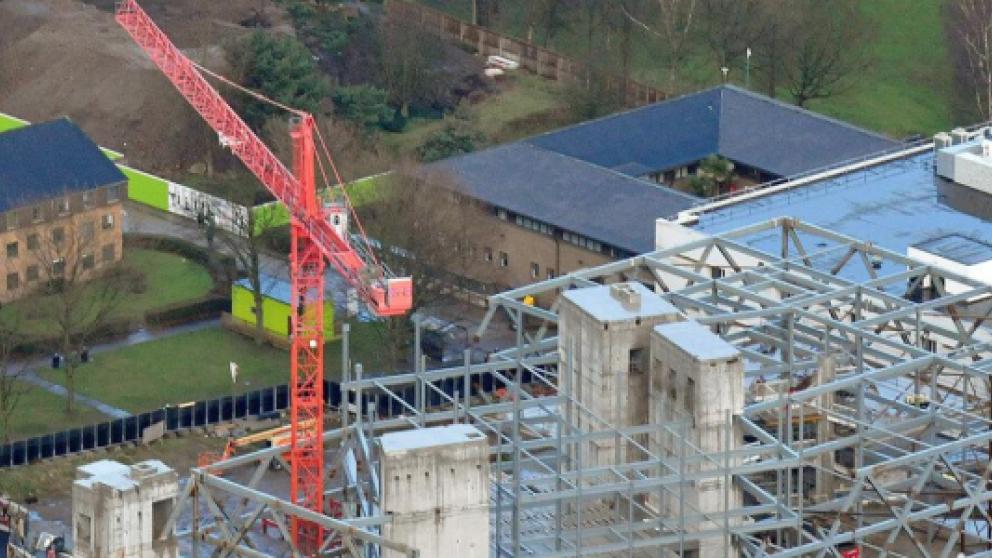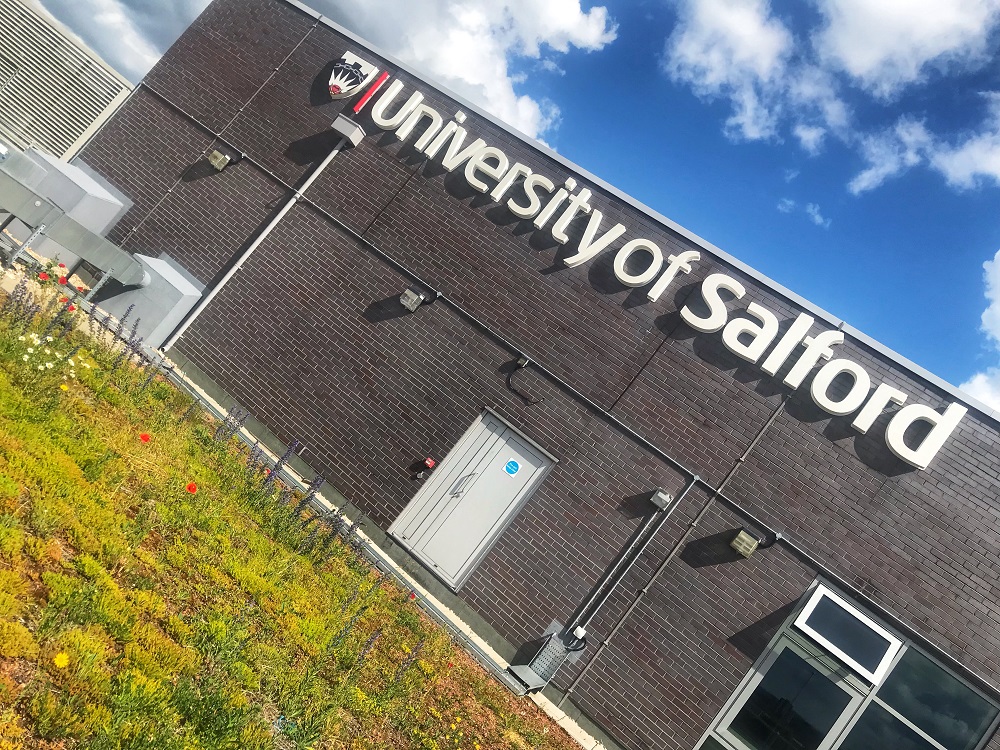Construction and refurbishment
We recognise that sustainability is part of a high performance building design process and so embed sustainability throughout the design and construction process. Clear sustainability requirements for each project are adopted and communicated to all people involved in the design process including key consultants and contractors. We enable sustainable construction through our Sustainable Construction Policy implemented through our procurement policies and processes and manage contractors onsite through our Contractor Management Code of Practice.
Our Sustainable Construction Policy provides a framework for sustainability in our construction projects. Our objectives are:
- To ensure all environmental risks are assessed, managed and controlled to minimise the impact of new build, refurbishment and maintenance projects;
- To promote and adopt best practice for sustainable design, construction and post occupancy management within the HE sector;
- To align our own practices in sustainable construction with our position as a leading institution for teaching and research in the built environment and energy;
- To consider and reduce whole life costs for new build and refurbishment project;
- To maintain and develop the University in a sustainable manner to reduce costs and meet the requirements of the Campus Masterplan, ISO 14001 and ISO 50001 Environment and Energy Management Systems, and Energy, Water and Carbon Management Plan;
- To keep the University community informed of this policy and its application across the University estate.
In delivering our commitment, all new building and major refurbishment projects will be assessed under formal sustainability schemes such as the Building Research Establishments (BREEAM) or Ska methodology to ensure energy efficiency and sustainability is maximised.
| Construction value | Target |
|---|---|
| New build and high value refurbishments | New Build BREEAM Excellent with consideration of Outstanding |
| Smaller new build and major refurbishments (above £1M) | Ska Gold or BREEAM Refurbishment and Fit-Out Excellent |
| Small refurbishments (£250k - £1M) | In-house 'mini-Ska' toolkit |
| Minor works/maintenance projects (£25k - £250k) | University of Salford Energy Design Standard |
The decision to proceed with the particular scheme and rating (BREEAM/Ska) will be made following a feasibility stage cost and benefits analysis. As a minimum ALL projects should meet the University of Salford Energy Design Standard.
Our role is to manage a project from conception to completion...
Head of ProjectsSustainable Development
As a Future Enabler, one of the key pan-university projects that will enable us to deliver the university’s vision, is our Campus Masterplan. Our aspirational vision for the next two decades will tap into the area’s unique potential to deliver a place to learn, live, work and visit. Our campus will link with local industry, as well as cultural and residential schemes to create a city district that enhances surrounding communities and helps to drive the economy both locally and regionally.
Environmental sustainability is a core element of the Campus Masterplan. Central to the plans is an energy strategy that takes a major step towards a zero carbon future, while providing high quality spaces for residential, teaching, research and commercial uses that are cost-effective to run. University of Salford buildings will undergo refurbishment to make them highly energy efficient, with maximum potential for renewable energy generation. To find out more about our Energy Strategy see our Carbon, Energy and Water pages.
The Masterplan will also look for opportunities for new green spaces in our urban environment to help promote learning, wellbeing and healthy lifestyles as well as consolidating and rationalising car-parking to reduce internal car circulation and promote a healthier, more pedestrian-friendly campus. The vision also promotes greater levels of cycling in and around the site. Improved pedestrian connections will be key to improving permeability across the campus – think tree-lined boulevards, public squares and a generally more well-defined network of routes and open spaces.
Sustainable Construction in Action
New Adelphi Building BREEAM Excellent
This building provides a new home on Peel Park Campus for the departments of music, performing arts and art & design, which were previously spread across several sites. The building facilitates creative cross-disciplinary working which enables the University to offer unique educational opportunities to students.
Technical facilities include a 350 capacity flexible theatre; two TV acting studios; performance rehearsal studios; six industry standard recording studios; 12 amplified music performance studios; 14 instrumental music tuition rooms; and a 100m2 ‘big band’ room. Flexible open-plan studios are accommodated on the upper storeys. A public atrium allows pedestrian routes through the building, as well as providing a café, multiple group working spaces and vertical circulation. The double-height steel truss rings that make up the perimeter of the upper two storeys create a gateway from Salford Crescent to the rest of Peel Campus.
The building achieved BREEAM Excellent and included the key innovative features and low-impact design features:
- Sedum roof
- Grey water harvesting
- Sustainable drainage
- Photovoltaics
- Natural ventilation / Building Management System
Clifford Whitworth Library Refurbishment
In 2016 and 2017, our Clifford Whitworth Library underwent a major refurbishment. The theme of the refurbishment was the “library in the park”, celebrating the fact that the University of Salford benefits from an attractive green campus, overlooking the historic Peel Park (the first municipal park in the UK).
The design incorporated elements which drew playfully upon this theme, such as a raised garden area with deck chairs, and park “pavilions” providing a focal point for activity on each floor. Previously, rather rigid study areas were replaced with light and airy spaces, with a variety of attractive technology-enabled study areas which allow students the freedom to learn in ways that feel comfortable.
As well as these benefits for the health and well-being for the users, extensive LED lighting was installed with a dimming facility attached to presence detection to enable energy savings of approximately 20% on the previous lighting design, giving 1.5 tonnes of carbon savings a year.
![]()
Castle Irwell Flood Basin and David Lewis Playing Fields
Working with the local community, the University, Salford City Council and the EA identified an opportunity to come together to use land owned by the University and the council to create a basin that will manage peak flows in the river Irwell, reducing the risk of flooding. The land which was the University’s sports fields was excavated with the material used to build an embankment around the basin. Rising river water flows over an inlet weir and is retained by penstocks until levels downstream subside and the water can be safely released back into the river. Works started on the project in March 2015 following extensive consultation with local community and environmental groups. Monthly sessions have continued over the life of the project with the feedback from community groups developing the end product. Examples of this include improved access arrangements, interpretation, habitat development eg otter holt provision and artworks.
The anticipated financial benefit to the local area from the scheme is at least £12m, including avoided costs of rehabilitation after flood events. In addition to reducing the flood risk from 1:75 to1:100 years, the scheme has created a 5.5ha wetland habitation, designed by The Wildfowl & Wetlands Trust with input from the community steering group. Approx. 5km of new paths have been created around the basin which will provide a valuable asset for the local community.
As part of the negotiations the University has agreed to exchange its sports pitches for council owned pitches adjoining the University campus. Whereas the University pitches have been exclusively for student use, all the pitches will be available to the community. The University’s grounds maintenance regime has improved the quality of the community pitches and will continue to improve the amenity value. Recently a 3G pitch has been added and the development of which included tree planting in line with our 2 for 1 tree replacement policy and a flood lighting scheme which was designed to be sensitive to bat activity in the area.


